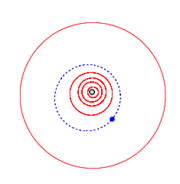(9948) 1990 QB2
(9948) 1990 QB2, provisional designation 1990 QB2, is a stony Nysian asteroid from the inner region of the asteroid belt, approximately 3.4 kilometers (2.1 miles) in diameter. It was discovered on 22 August 1990, by American astronomer Henry Holt at the Palomar Observatory in California.[1] The likely elongated S-type asteroid has a rotation period of 3.53 hours.[3] This asteroid has not been named.[1]
 | |
| Discovery [1] | |
|---|---|
| Discovered by | H. E. Holt |
| Discovery site | Palomar Obs. |
| Discovery date | 22 August 1990 |
| Designations | |
| (9948) 1990 QB2 | |
| 1990 QB2 · 1979 SJ6 1990 SQ26 | |
| main-belt [1][2] · (inner)[3] Nysa [4] | |
| Orbital characteristics [2] | |
| Epoch 23 March 2018 (JD 2458200.5) | |
| Uncertainty parameter 0 | |
| Observation arc | 38.43 yr (14,035 d) |
| Aphelion | 2.9012 AU |
| Perihelion | 1.8657 AU |
| 2.3835 AU | |
| Eccentricity | 0.2172 |
| 3.68 yr (1,344 d) | |
| 187.50° | |
| 0° 16m 4.08s / day | |
| Inclination | 2.0964° |
| 171.55° | |
| 151.67° | |
| Physical characteristics | |
Mean diameter | 3.345±0.717 km[5][6] 3.351 km[7] |
| 3.523±0.0025 h (R)[8] 3.5257±0.0007 h[9] 3.53±0.010 h (R)[10] | |
| 0.2232[7] 0.250±0.093[5][6] | |
| S (SDSS-MOC)[11] S (Pan-STARRS)[12] | |
| 13.79±0.54[12] 14.290±0.200 (R)[10] 14.3[2] 14.338±0.004 (R)[8] 14.5[6] 14.62[3][7] | |
Orbit and classification
1990 QB2 is member of the Nysa family (405),[4] located in the Nysa–Polana complex. It is named after 44 Nysa and one of the largest families in the main belt.[13]:23
The asteroid orbits the Sun in the inner asteroid belt at a distance of 1.9–2.9 AU once every 3 years and 8 months (1,344 days; semi-major axis of 2.38 AU). Its orbit has an eccentricity of 0.22 and an inclination of 2° with respect to the ecliptic.[2] The asteroid was first observed as 1979 SJ6 at Crimea–Nauchnij in September 1979. The body's observation arc begins at Palomar with its official discovery observation in 1990.[1]
Physical characteristics
1990 QB2 has been characterized as a common, stony S-type asteroid by Pan-STARRS' survey and in the SDSS-based taxonomy.[3][11][12]
Rotation period
In November 2005, a first rotational lightcurve of 1990 QB2 was obtained from photometric observations by Australian amateur astronomer David Higgins. Lightcurve analysis gave a well-defined rotation period of 3.5257 hours with a high brightness variation of 0.77 magnitude (U=3).[9] In January 2014, observations in the R-band at the Palomar Transient Factory in California gave two concurring periods of 3.523 and 3.53 hours with an amplitude of 0.60 magnitude (U=2/2).[8][10] A high brightness amplitude typically indicates that the body has a non-spherical shape
Diameter and albedo
According to the survey carried out by the NEOWISE mission of NASA's Wide-field Infrared Survey Explorer, 1990 QB2 measures 3.345 kilometers in diameter and its surface has an albedo of 0.250.[5][6] The Collaborative Asteroid Lightcurve Link adopts Petr Pravec's revised WISE-result, that is, an albedo of 0.2232 and a diameter of 3.351 kilometers based on an absolute magnitude of 14.62.[3][7]
Naming
This minor planet was numbered on 2 February 1999 (M.P.C. 33659).[14] As of 2018, it has not been named.[1]
References
- "9948 (1990 QB2)". Minor Planet Center. Retrieved 31 May 2018.
- "JPL Small-Body Database Browser: 9948 (1990 QB2)" (2018-02-25 last obs.). Jet Propulsion Laboratory. Retrieved 31 May 2018.
- "LCDB Data for (9948)". Asteroid Lightcurve Database (LCDB). Retrieved 31 May 2018.
- "Asteroid (9948) 1990 QB2". Small Bodies Data Ferret. Retrieved 31 May 2018.
- Masiero, Joseph R.; Mainzer, A. K.; Grav, T.; Bauer, J. M.; Cutri, R. M.; Dailey, J.; et al. (November 2011). "Main Belt Asteroids with WISE/NEOWISE. I. Preliminary Albedos and Diameters". The Astrophysical Journal. 741 (2): 20. arXiv:1109.4096. Bibcode:2011ApJ...741...68M. doi:10.1088/0004-637X/741/2/68.
- Mainzer, A.; Grav, T.; Masiero, J.; Hand, E.; Bauer, J.; Tholen, D.; et al. (November 2011). "NEOWISE Studies of Spectrophotometrically Classified Asteroids: Preliminary Results". The Astrophysical Journal. 741 (2): 25. arXiv:1109.6407. Bibcode:2011ApJ...741...90M. doi:10.1088/0004-637X/741/2/90. (catalog)
- Pravec, Petr; Harris, Alan W.; Kusnirák, Peter; Galád, Adrián; Hornoch, Kamil (September 2012). "Absolute magnitudes of asteroids and a revision of asteroid albedo estimates from WISE thermal observations". Icarus. 221 (1): 365–387. Bibcode:2012Icar..221..365P. doi:10.1016/j.icarus.2012.07.026.
- Waszczak, Adam; Chang, Chan-Kao; Ofek, Eran O.; Laher, Russ; Masci, Frank; Levitan, David; et al. (September 2015). "Asteroid Light Curves from the Palomar Transient Factory Survey: Rotation Periods and Phase Functions from Sparse Photometry". The Astronomical Journal. 150 (3): 35. arXiv:1504.04041. Bibcode:2015AJ....150...75W. doi:10.1088/0004-6256/150/3/75.
- Higgins, David; Pravec, Petr; Kusnirak, Peter; Reddy, Vishnu; Dyvig, Ron (September 2006). "Asteroid lightcurve analysis at Hunters Hill Observatory and collaborating stations - summer 2005/6". The Minor Planet Bulletin. 33 (3): 64–66. Bibcode:2006MPBu...33...64H. ISSN 1052-8091.
- Chang, Chan-Kao; Ip, Wing-Huen; Lin, Hsing-Wen; Cheng, Yu-Chi; Ngeow, Chow-Choong; Yang, Ting-Chang; et al. (August 2015). "Asteroid Spin-rate Study Using the Intermediate Palomar Transient Factory". The Astrophysical Journal Supplement Series. 219 (2): 19. arXiv:1506.08493. Bibcode:2015ApJS..219...27C. doi:10.1088/0067-0049/219/2/27.
- Carvano, J. M.; Hasselmann, P. H.; Lazzaro, D.; Mothé-Diniz, T. (February 2010). "SDSS-based taxonomic classification and orbital distribution of main belt asteroids". Astronomy and Astrophysics. 510: 12. Bibcode:2010A&A...510A..43C. doi:10.1051/0004-6361/200913322. Retrieved 30 October 2019. (PDS data set)
- Veres, Peter; Jedicke, Robert; Fitzsimmons, Alan; Denneau, Larry; Granvik, Mikael; Bolin, Bryce; et al. (November 2015). "Absolute magnitudes and slope parameters for 250,000 asteroids observed by Pan-STARRS PS1 - Preliminary results". Icarus. 261: 34–47. arXiv:1506.00762. Bibcode:2015Icar..261...34V. doi:10.1016/j.icarus.2015.08.007.
- Nesvorný, D.; Broz, M.; Carruba, V. (December 2014). Identification and Dynamical Properties of Asteroid Families. Asteroids IV. pp. 297–321. arXiv:1502.01628. Bibcode:2015aste.book..297N. doi:10.2458/azu_uapress_9780816532131-ch016. ISBN 9780816532131.
- "MPC/MPO/MPS Archive". Minor Planet Center. Retrieved 31 May 2018.
External links
- Asteroid Lightcurve Database (LCDB), query form (info)
- Discovery Circumstances: Numbered Minor Planets (5001)-(10000) – Minor Planet Center
- (9948) 1990 QB2 at AstDyS-2, Asteroids—Dynamic Site
- (9948) 1990 QB2 at the JPL Small-Body Database
